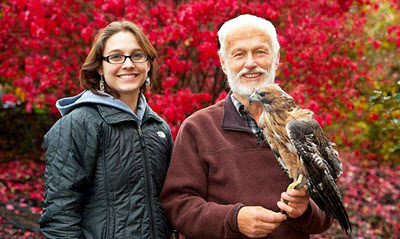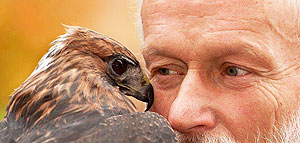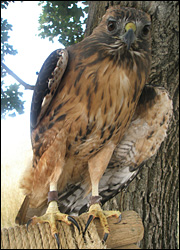I hope this article brings you good cheer. I found it when researching red-tailed hawks in captivity.
Source: https://news.wsu.edu/2011/11/14/wsu-home-to-oldest-red-tailed-hawk-on-record/
Retired WSU veterinarian Erik Stauber saved Charlie’s life more than 30 years ago. Today, WSU Raptor Club member Sarah Monzel helps care for him. (Photos by Shelly Hanks, WSU Photo Services)
PULLMAN, Wash. – The planet’s most famous red-tailed hawk is Pale Male of New York City, whose home is a ledge on a posh high-rise overlooking Central Park where a “Hawk Cam” entertains his adoring fans.
But make way for Charlie, a red-tailed hawk whose home is Washington State University.
Charlie may not have a fashionable perch or books and a documentary film made about him. But Charlie – who lives at WSU’s Carver Raptor Facility – deserves celebrity status for being one tough old bird. At age 30, he has lived longer than any red-tailed hawk on record.
And he’s healthy to boot.
News of Charlie’s age has been trickling out among bird experts around the country.
“What a terrific story – truly amazing,” said George Fenwick, president of the American Bird Conservancy in Plains, Va.
“Very interesting,” responded John Blakeman, a raptor biologist from Ohio who said he plans to write about Charlie’s achievement in a comprehensive book about raptors.
Trust and respect for 30 years. (Don’t attempt to nuzzle a hawk yourself. Stauber is considered a guru of falconry.)
One for the books
The average life span for a red-tail in the wild is 10-15 years – for those in captivity, 20 years – according to research. The oldest recorded red-tailed hawk died at 30.8 years last February in Michigan, according to “Longevity Records of North American Birds,” compiled by the U.S. Geological Survey’s Patuxent Wildlife Research Center in Maryland.
With Charlie still alive and healthy at 30.9 years, he appears to have broken the posted record, said ecology biologist Charles Preston, a leading expert on red-tailed hawks in Cody, Wyo., who wrote “Wild Bird Guides: Red-tailed Hawk.” (Stackpole Books, 2000)
The comeback king
Charlie was brought to WSU’s College of Veterinary Medicine in 1981, the year Ronald Reagan became president, a first-class stamp cost 18 cents and “Raiders of the Lost Ark” was released. At three months old, he was found injured at the side of a road after being struck by a car, said Erik Stauber, retired WSU veterinary professor and raptor specialist who treated Charlie’s wing and skull fractures.
“After his injuries healed, we saw that he could no longer fly. Knowing he’d never survive on his own, we made him our first permanent raptor resident,” said Stauber, who became Charlie’s primary trainer.
Charlie’s injuries may have left him permanently disabled but, like all birds of prey, he’s armed with powerful talons for piercing and crushing his target. And like any wild bird, he got ornery when approached by humans.
“He didn’t like me much,” recalled Stauber. “He’d glare, open and close his beak and fluff up.” But that didn’t bother Stauber, a falconer since 1956 licensed by the state of Washington to handle raptors.
As Charlie became used to people, “He became a gentle bird,” said Stauber, who used him to teach veterinary students about raptors and also to teach the public about the important role they play in the ecosystem by eating pesky rodents.
Secrets of his success
Why has Charlie lived so long and in such good health?
“I think that Charlie’s advanced age is a credit to all of the folks who have taken good care of him in captivity,” said Preston, the red-tailed hawk expert and author in Wyoming.
Those folks include a gaggle of devoted students. The year Charlie came to campus, Stauber organized WSU’s Raptor Club, made up mostly of student volunteers who feed, exercise and monitor non-releasable raptors.
Today, one of them is animal-sciences major Sarah Monzel, a self-described “bird nerd” who has nurtured Charlie for three years. Talk about fans of a feather. On her touch-screen cell phone is a photo of Charlie.
“Isn’t he beautiful?” she asks upon entering Charlie’s mew inside the Carver Raptor Facility.
Inside a room with skylights, pine branches and a pumpkin carved into a rodent shape, Charlie stands majestically on his perch, his tail feathers marbled in brick-red and gray. His deep brown eyes, registered squarely on his two guests, are arched by large ridges that make him look all-knowing.
“Hi Charlie. How’s my old man today?” asked Monzel as she approached. Then, holding out her hand covered in a thick leather glove extending to the elbow, she instructed: “Step up.”
Charlie, with his injured left wing drooping slightly, stepped off his perch and onto her arm.
For Monzel, Charlie symbolizes the resiliency of injured raptors cared for by the very creatures who harm them: Humans. Too often, birds of prey are killed or left permanently disabled by hunters’ bullets (despite laws making this illegal), speeding cars, electrocution and poison, she said.
Which is largely why WSU’s Veterinary Teaching Hospital treats roughly 100 injured or ill raptors each year, said WSU exotics and wildlife veterinarian Nickol Finch, the Raptor Club’s advisor since Stauber retired in January. While many of those birds heal and get released back to the wild, others, like Charlie, would die.
“Not only did Charlie survive – he thrived,” said Monzel, who, along with other club members, gives him walks, feedings, medicine for mild arthritis and a supplement called Vitahawk.
And so, as Pale Male soars from his classy digs in New York to find food and a new girlfriend, Charlie’s role is more down to earth. For three decades, he has perched patiently during dozens of presentations at schools, fairs and 4-H events, allowing people to see a two-pound force of nature up close and personal, said Monzel.
And each new day that she walks in and says, “Hi Charlie. How’s my old man today?” a new record will be set.
Sarah Monzel and other WSU Raptor Club members walk Charlie almost daily.
Sources:
Nickol Finch, WSU veterinarian, nfinch@vetmed.wsu.edu
Sarah Monzel, WSU Raptor Club, wsuraptorprogram@gmail.com
Erik Stauber, retired WSU veterinarian and raptor specialist, 208-882-1133




